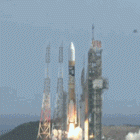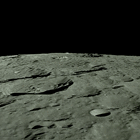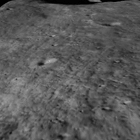Kaguya lifts off
 The Japanese space agency, JAXA, launches the unmanned SELENE (Selenological and Engineering Explorer) spacecraft to orbit Earth’s moon. SELENE is nicknamed Kaguya after a princess of the moon from Japanese folklore. Kaguya is scheduled to enter a polar lunar orbit in October, where it will conduct experiments in spectography, radio science, and charged particle and gamma ray detection. Though Kaguya has an on-board camera to map lunar terrain, the views for which it will become most famous will be shot by two HDTV cameras supplied by Japanese television network NHK, providing spectacular views of the lunar surface as they would be seen by an orbiting explorer.
The Japanese space agency, JAXA, launches the unmanned SELENE (Selenological and Engineering Explorer) spacecraft to orbit Earth’s moon. SELENE is nicknamed Kaguya after a princess of the moon from Japanese folklore. Kaguya is scheduled to enter a polar lunar orbit in October, where it will conduct experiments in spectography, radio science, and charged particle and gamma ray detection. Though Kaguya has an on-board camera to map lunar terrain, the views for which it will become most famous will be shot by two HDTV cameras supplied by Japanese television network NHK, providing spectacular views of the lunar surface as they would be seen by an orbiting explorer.

 Japan’s unmanned Kaguya spacecraft, also known as SELENE, enters a polar orbit around Earth’s moon with an average altitude of 62 miles. Billed by Japanese space agency JAXA as the most significant lunar mission since the Apollo era, Kaguya carries numerous science experiments, though the public is most captivated by video transmitted back to Earth from two on-board HDTV cameras supplied by television network NHK. Kaguya conducts accurate gravitational mapping of the far side of the moon for the first time, and its own terrain camera obtains high-resolution mapping data, which will later be shared with Google for an online 3-D map of the moon.
Japan’s unmanned Kaguya spacecraft, also known as SELENE, enters a polar orbit around Earth’s moon with an average altitude of 62 miles. Billed by Japanese space agency JAXA as the most significant lunar mission since the Apollo era, Kaguya carries numerous science experiments, though the public is most captivated by video transmitted back to Earth from two on-board HDTV cameras supplied by television network NHK. Kaguya conducts accurate gravitational mapping of the far side of the moon for the first time, and its own terrain camera obtains high-resolution mapping data, which will later be shared with Google for an online 3-D map of the moon. Japan’s unmanned Kaguya spacecraft, also known as SELENE, is intentionally crashed into the surface of Earth’s moon, which it has been orbiting and studying for nearly two years (twice its intended one-year operational lifetime). Having completed its observations and studies (as well as transmitting back to Earth high-definition camera views of the moon from orbit), Kaguya impacts near the crater Gill.
Japan’s unmanned Kaguya spacecraft, also known as SELENE, is intentionally crashed into the surface of Earth’s moon, which it has been orbiting and studying for nearly two years (twice its intended one-year operational lifetime). Having completed its observations and studies (as well as transmitting back to Earth high-definition camera views of the moon from orbit), Kaguya impacts near the crater Gill.